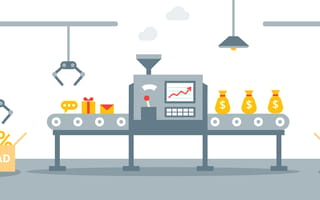Picture your sales pipeline as an actively moving conveyor belt.
Through hard work and passion for your product, you have successfully placed multiple prospects along the belt. With unique timelines, each prospect is positioned at different points, but they are all steadily progressing toward closing a deal with you.
As your conveyor belt welcomes more prospects, with some wanting it to speed up and others needing it to slow down, it can be challenging to ensure that everyone has a pleasant, bump-free journey.
Sales leaders from two Boston-based companies, Upwork and InterSystems, know firsthand how difficult it is to keep the conveyor belt running smoothly.
By committing to a number of best practices — including crafting mutually agreed-upon timelines with clients and dedicating weekly calendar blocks to information updates — these featured leaders are expertly monitoring and maintaining their sales pipelines. With organized and accurate pipelines, they are able to effectively advise and service their clients, ensuring an enjoyable experience for all.
They have important tips and tricks for sales representatives who are eager to evolve into top performers — and they’re hiring now.

Upwork is an HR tech company that connects businesses to independent talent.
What’s your best practice when it comes to pipeline management?
I set expectations with the client, have them agree to a mutual timeline and work backward from there. I am always honest with myself when I think deals will close and give myself wiggle room for unexpected delays that inevitably come up in a deal. This practice is important so you can be accurate in forecasting. It also gives you a full picture of the deficit in your bookings versus your quota.
Communicating your pipeline with your partners and management is incredibly important so everyone is on the same page and agrees with your timeline for each deal. That way, internal resources are more accurately forecasted, as well.
What’s one improvement that you made to your pipeline processes?
Creating a mutual close plan with the client has been so helpful and valuable, both internally and externally. When I work on this timeline in partnership with the client, it doesn’t feel like the timeline is my own. Together, we agree on how long it will take and what the necessary steps are in order to make the partnership a success for both parties.
Creating a mutual close plan with the client has been so helpful and valuable, both internally and externally.”
The mutual close plan uncovers hidden roadblocks and key decision makers, while holding each party accountable. This process has allowed me to speed up the deal cycle and have a more accurate pipeline. It’s also something I use as a status check throughout the lifecycle of the deal.
This document helps to keep the communication and momentum going during our weekly or biweekly status meetings. I bring up the mutual close plan on the status meetings and update accordingly. It’s also used as a follow-up email to each status call.
What’s your best practice for monitoring your sales pipeline and keeping it up to date?
Every Friday, I update my pipeline — it’s noted on my calendar so I don’t forget — along with meetings and notes based on that week’s discussions. I look to see if my pipeline is “bloated” in one stage or another and where I need to focus on pushing deals along.
For example, if I have too many deals in our demo stage, I focus on having a next step for my proposals with each of those accounts and make that my pipeline goal for the week. I also go through each opportunity and see where I don’t have a next step and make that focus for pipeline management.
Crafting the mutual close plan also realistically lays out how long each process in the deal will take, and then I put a cushion on that to account for hiccups, roadblocks and delays.

InterSystems is a Cambridge-based big data company that powers an information engine for healthcare, business and government applications.
What’s your best practice when it comes to pipeline management?
At each and every touch point with a prospect or customer, I deliver value in some way. I’m not a salesperson selling a particular product. My goal is to serve as a trusted adviser. I build trust with the prospect and they seek out assistance, opinions and insights to solve business problems. Prospects and customers derive great value from that.
InterSystems delivers products and services that solve complex problems. Prospects who come to us often do not have a defined product that they’re looking for, but they have a problem that they don’t know how to solve. When they approach a vendor like InterSystems, prospects are not just looking for a product, they’re looking for guidance on how to solve a business problem.
We’ve done this for 45 years and developed extensive knowledge in these areas. We can define a path to get your business to a solution.
Overall, I think it’s worth remembering that InterSystems is only successful if our customers are successful. We invest our time and energy into customers so that they’re in the best position for success, technically and financially.
What’s one improvement that you made to your pipeline processes?
The focus on the qualification process. My team and I are always qualifying and re-qualifying opportunities. That way, we spend our time with prospects who have the potential to close business for InterSystems.
It’s all about efficient use of our time. We continually re-qualify opportunities and separate those who are prepared to move forward with an agreement from those who might be a secondary priority.
Re-qualifying means staying engaged with the prospect and understanding the importance and priority of the project, timeline and budget. We’re making sure that there is a high potential for closing in the future. We spend time with people who have a defined project, budget and problems that we can solve.
The focus on the qualification process. My team and I are always qualifying and re-qualifying opportunities.”
What’s your best practice for monitoring your sales pipeline and keeping it up to date?
Some people may not prioritize pipeline maintenance, the review of your pipeline in document form. Dedicating blocked-out time to updating your pipeline and keeping it accurate is really important. Part of reporting to my boss is to report my pipeline, so I have to do it every single week; there’s accountability built in.
Just like with re-qualifying, this is about being efficient with my time. I am a lot more effective when I know where the information exists and that it’s up to date.
I work primarily with startups — I’m not working two enterprise details in a year. I have 30 opportunities in my pipeline, so it’s essential that I’m organized, timely and accurate so that when I communicate with a prospect, I know what I say resonates.
It’s important to always be filling the top of the pipeline funnel. There are times when we need to prioritize closing business, but even then, dedicate time to filling the top of the funnel with prospects and searching for new opportunities. It may not affect you today, but it affects you down the road. You need to have consistent closings, and the only way to do so is by filling the prospects at the top of the funnel.









